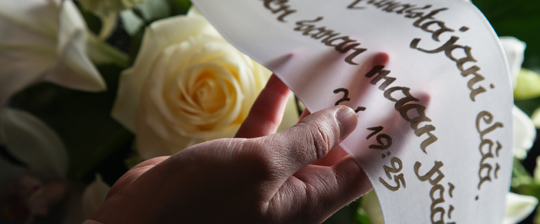|
|

The funeral processionMale relatives of the deceased normally act as pallbearers, with the closest relatives at the head of the coffin. The coffin is always carried foot-end first. If enough pallbearers cannot be found among the mourners, the funeral director can be requested to arrange bearers. The coffin is carried out of the chapel while the closing music is playing and placed on a lightweight trolley waiting outside. Mourners proceed to the grave in procession, guided by an attendant and followed by the bearers of the coffin, then the family and after them the rest of the mourners. The minister walks either ahead of the coffin or behind it with the family. Mourners remain silent during the procession. Silence gives space for the feelings of sorrow and an opportunity to pay respect and offer prayers. Those who find it difficult to walk can join the procession in a car or go directly to the grave by car. When at the grave, the coffin is positioned such that the head end is toward the headstone. When the coffin is lowered, male mourners take off their hats. The bearers do this only after lowering the coffin into the grave, after which they stand for a moment at the graveside. The minister may say a short prayer. These days, the grave is not filled straightaway but covered with a lid. The family may want to throw some soil or flowers on the coffin before this is done. If they so wish, the family may throw enough soil on the grave to cover the coffin. This should be agreed on in advance. After the flowers are placed on the grave, it is customary to sing a hymn. Then, one of the mourners presents an invitation to the funeral reception, if one is to be held. |